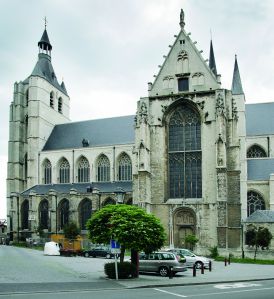Church | XIV | Gothic | Catholic Church


Map
Opening hours
01 April - 31 October
Mon -
Tue 13.00 - 17.00
Wed 13.00 - 17.00
Thu 13.00 - 17.00
Fri 13.00 - 17.00
Sat 13.00 - 17.00
Sun 13.00 - 17.00
01 November - 31 March
Mon -
Tue 13.00 - 16.00
Wed 13.00 - 16.00
Thu 13.00 - 16.00
Fri 13.00 - 16.00
Sat 13.00 - 16.00
Sun 13.00 - 16.00
Guided tour
Religious offices
Description
At the end of the steep road the Square you have the church Our Lady beyond the Dyle. She was built in the 14th, 15th and 16th century in Brabantine Gothic in replacement of the oldest parish church of Malines.
The rich interior of the church was partly financed by the trades and the guilds who had earlier their own altar, decorated with masterpieces that represented the prestige of the guild or the trade. The triptych of the fish-hawkers painted by Rubens and the Saint-Antoine triptych of Michiel II Coxie are remainders of these.
Also the pieces that are not relied to the guilds or trades are worth seeing. So we have the tower of sacraments, the baroque high altar with the Last Supper of Jan Erasmus Quellinus, the wall-painting of the 16th century with the gospel of the lost son, the organ and the pulpit.
Despite the art-treasures that were kept until now, the church is only a shade of its former self. Especially in the 20th century the demolitions, during both World Wars, took a heavy toll, resulting in an enormous shrinking of the church patrimony. As first parish church, as second important church in Malines, she could concerning richness compete without doubt with the Church of Saint-Jan, which was built later on.
Because of that lost richness, there come about a feeling of space that surprises you by entering. That game of light, created by the window-frames of the sixties, just reinforces this timeless feeling.
The church Our Lady beyond the Dyle is governed together with the other seven historical churches in Malines by Torens aan de Dijle together with the city Malines.
Photos
Media
Remarkable elements
Modern stained glass windows
A prominent feature of this church is the unique display of light and colour entering via the stained glass windows, creating a special athmosphere. The windows (1960-1968) were designed by architect Jan Lauwers, almost all created by glazier Calders (Mortsel) and replace the 19th century windows destroyed in 1945 during the second world war.“The miraculous fishing” by P.P. Rubens
In this church since 1619, the painting is a prime example of the baroque style favoured by Rubens around 1620. It is a paneled painting first made for the altar of the church of the fishmongers in Malines. In 1794, during the French Revolution, it was sent to Paris. The top triptych returned in 1816. The two end panels of the lower part remained in France. The middle part remained lost until it was rediscovered by carillon player Jo Haazen in Russia, on loan from the Hermitage in Saint Petersburg.Sacrament tower
This neo-gothic eye-catching sculpture in white stone dates from 1903 and was made by B. Van Uytvanck.Our Lady of the Scheve-Lee
From the 14th century, this is the oldest sculpture in the church and possibly the only free-standing one from that period. The name refers to the slanting stand of the hips of the Holy Mary.Wall painting “Parable of the lost son”
This may be the most intriguing work of art here (in the 3rd chapel of the south choir deambulatory. This fresco dates from the 16th century and is conceived as a narrative painting, starting at the bottom to be read from left to right and back at the top.Organ and carillon
The organ is new, dating from 1958-68 made from old preserved wood and mounted in the restored casing from 1559 with a baroque front. The organist is Wannes Vanderhoeven.
The modern carillon, built under supervision of Staf Nees, dates from 1965, except for the 5 ringing bells (1947-1962) It contains 50 bells weighing a total of 9,123kg. Every 1st and 3rd Saturday of the month at 11am, the carillon is played by our carillonneur Dina Verheyden. Two carillon concerts also take place every summer.

































